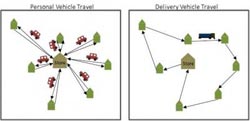Grocery delivery service is greener than driving to the store

This diagram shows how a delivery truck can save on mileage when compared with personal vehicles driving to and from a store. Credit: Goodchild/Wygonik, UW<br>
University of Washington engineers have found that using a grocery delivery service can cut carbon dioxide emissions by at least half when compared with individual household trips to the store. Trucks filled to capacity that deliver to customers clustered in neighborhoods produced the most savings in carbon dioxide emissions.
“A lot of times people think they have to inconvenience themselves to be greener, and that actually isn't the case here,” said Anne Goodchild, UW associate professor of civil and environmental engineering. “From an environmental perspective, grocery delivery services overwhelmingly can provide emissions reductions.”
Consumers have increasingly more grocery delivery services to choose from. AmazonFresh operates in the Seattle area, while Safeway's service is offered in many U.S. cities. FreshDirect delivers to residences and offices in the New York City area. Last month, Google unveiled a shopping delivery service experiment in the San Francisco Bay Area, and UW alumni recently launched the grocery service Geniusdelivery in Seattle.
As companies continue to weigh the costs and benefits of offering a delivery service, Goodchild and Erica Wygonik, a UW doctoral candidate in civil and environmental engineering, looked at whether using a grocery delivery service was better for the environment, with Seattle as a test case. In their analysis, they found delivery service trucks produced 20 to 75 percent less carbon dioxide than the corresponding personal vehicles driven to and from a grocery store.
They also discovered significant savings for companies – 80 to 90 percent less carbon dioxide emitted – if they delivered based on routes that clustered customers together, instead of catering to individual household requests for specific delivery times.
“What's good for the bottom line of the delivery service provider is generally going to be good for the environment, because fuel is such a big contributor to operating costs and greenhouse gas emissions,” Wygonik said. “Saving fuel saves money, which also saves on emissions.”
The research was funded by the Oregon Department of Transportation and published in the Journal of the Transportation Research Forum.
The UW researchers compiled Seattle and King County data, assuming that every household was a possible delivery-service customer. Then, they randomly drew a portion of those households from that data to identify customers and assign them to their closest grocery store. This allowed them to reach across the entire city, without bias toward factors such as demographics and income level.
They used an Environmental Protection Agency modeling tool to calculate emissions at a much more detailed level than previous studies have done. Using factors such as vehicle type, speed and roadway type, they calculated the carbon dioxide produced for every mile for every vehicle.
Emissions reductions were seen across both the densest parts and more suburban areas of Seattle. This suggests that grocery delivery in rural areas could lower carbon dioxide production quite dramatically.
“We tend to think of grocery delivery services as benefiting urban areas, but they have really significant potential to offset the environmental impacts of personal shopping in rural areas as well,” Wygonik said.
Work commuters are offered a number of incentives to reduce traffic on the roads through discounted transit fares, vanpools and carpooling options. Given the emissions reductions possible through grocery delivery services, the research raises the question of whether government or industry leaders should consider incentives for consumers to order their groceries online and save on trips to the store, Goodchild said.
In the future, Goodchild and Wygonik plan to look at the influence of customers combining their grocery shopping with a work commute trip and the impact of the delivery service's home-base location on emissions.
For more information, contact Goodchild at annegood@uw.edu or 206-543-3747.
Media Contact
More Information:
http://www.uw.eduAll latest news from the category: Ecology, The Environment and Conservation
This complex theme deals primarily with interactions between organisms and the environmental factors that impact them, but to a greater extent between individual inanimate environmental factors.
innovations-report offers informative reports and articles on topics such as climate protection, landscape conservation, ecological systems, wildlife and nature parks and ecosystem efficiency and balance.
Newest articles

Webb captures top of iconic horsehead nebula in unprecedented detail
NASA’s James Webb Space Telescope has captured the sharpest infrared images to date of a zoomed-in portion of one of the most distinctive objects in our skies, the Horsehead Nebula….

Cost-effective, high-capacity, and cyclable lithium-ion battery cathodes
Charge-recharge cycling of lithium-superrich iron oxide, a cost-effective and high-capacity cathode for new-generation lithium-ion batteries, can be greatly improved by doping with readily available mineral elements. The energy capacity and…

Novel genetic plant regeneration approach
…without the application of phytohormones. Researchers develop a novel plant regeneration approach by modulating the expression of genes that control plant cell differentiation. For ages now, plants have been the…





















